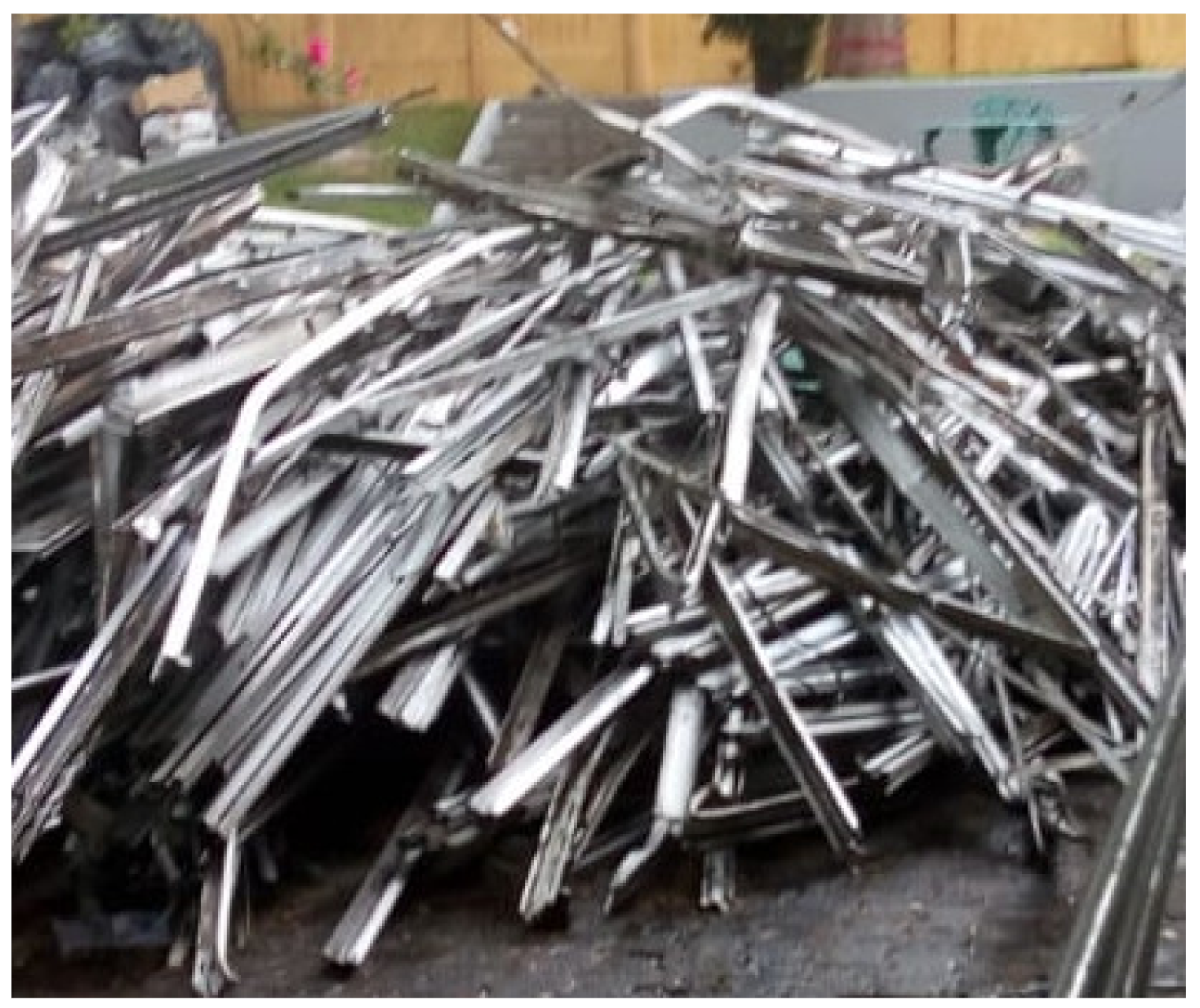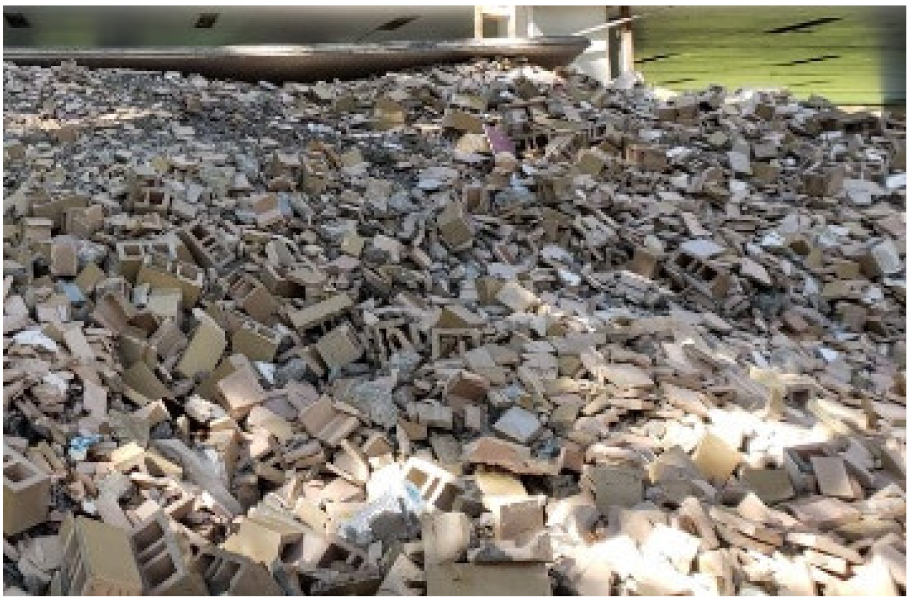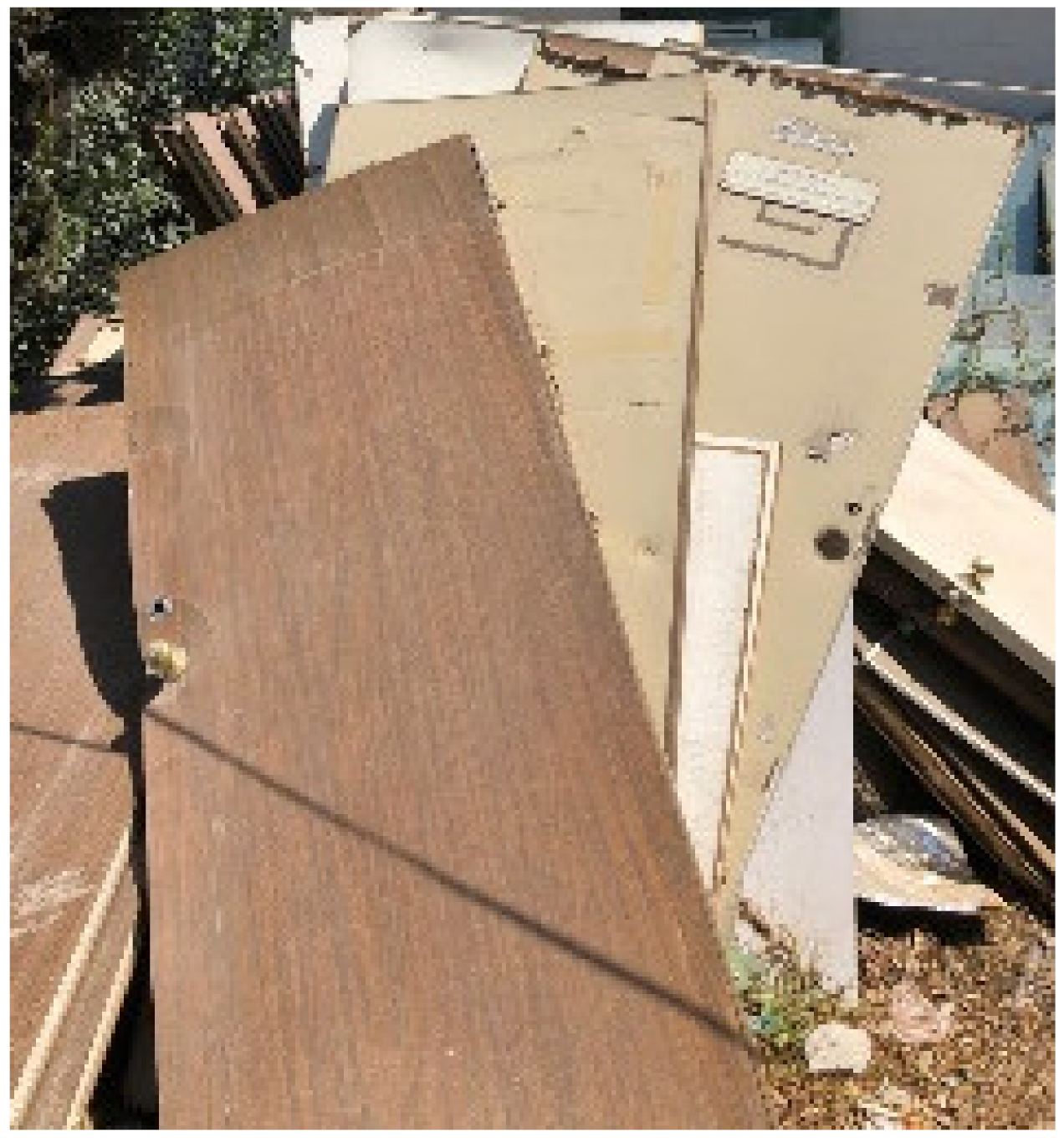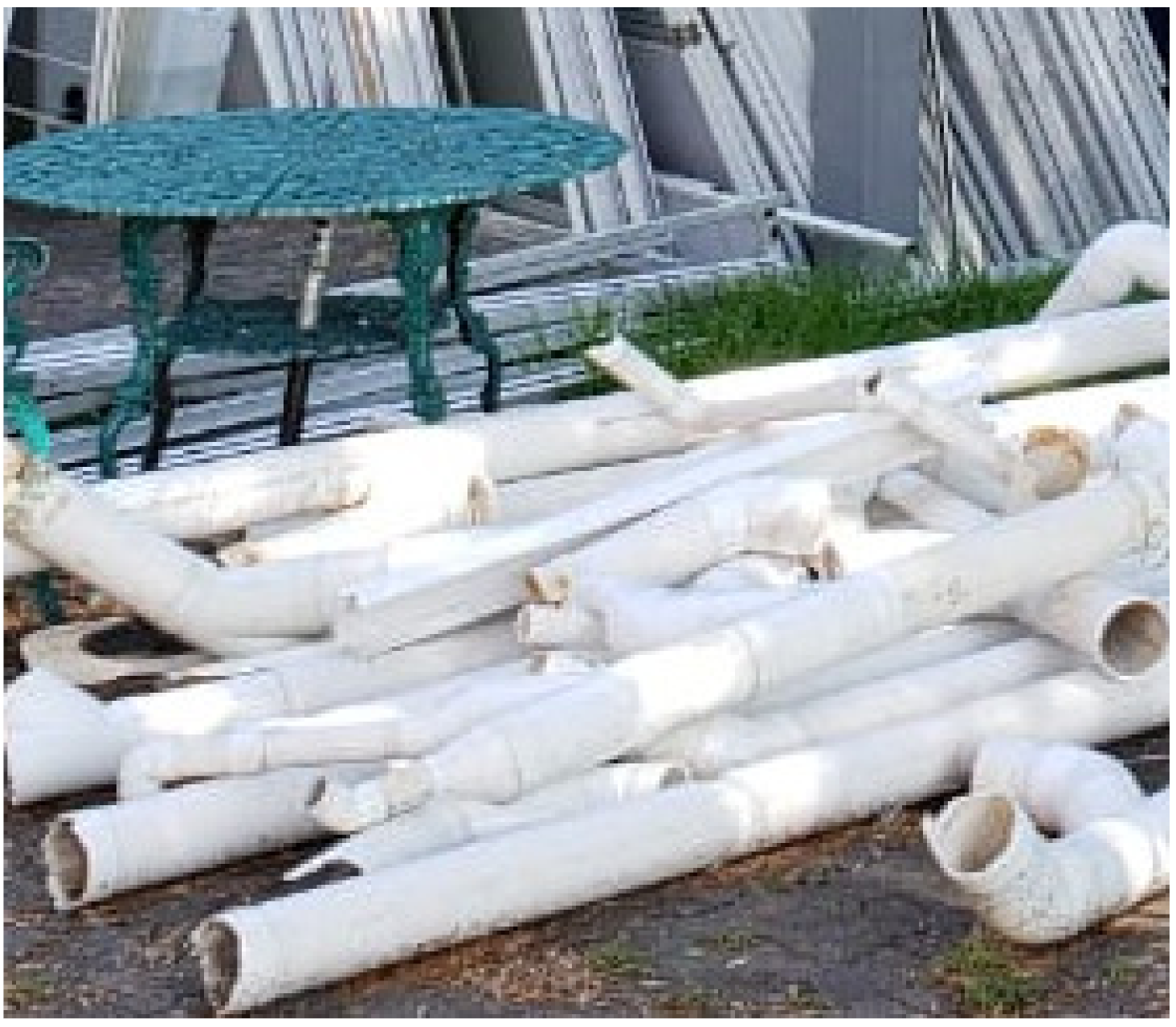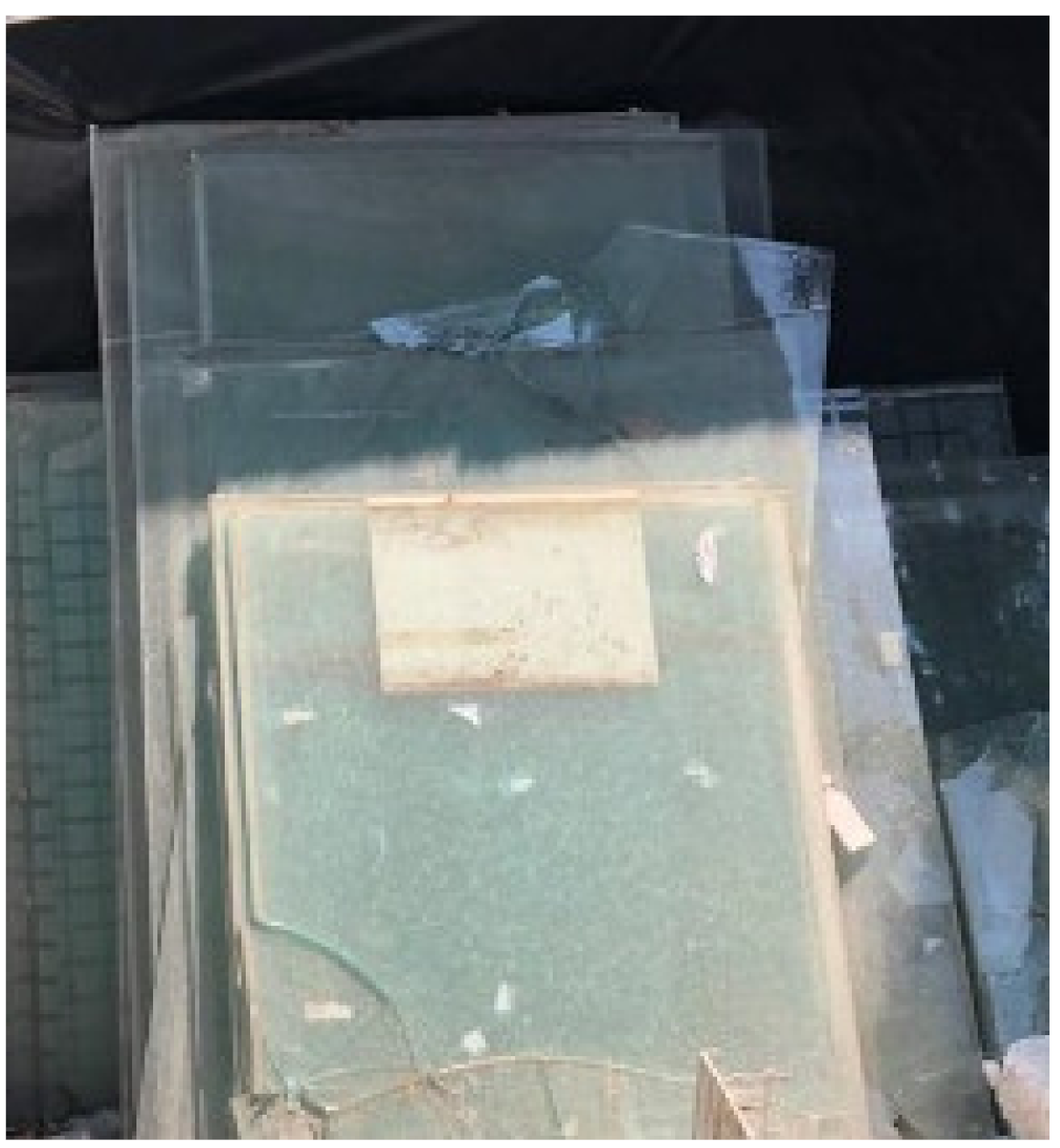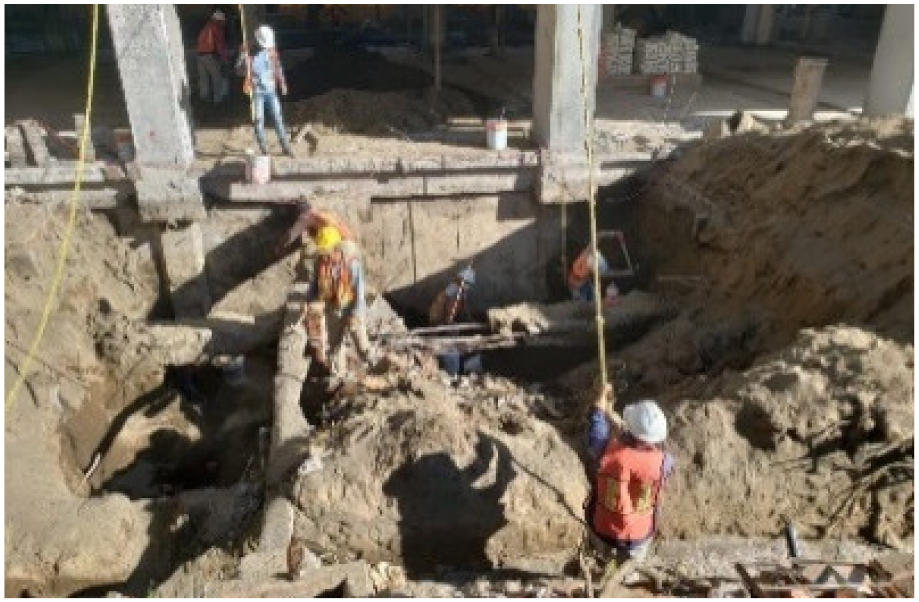Abstract
After a seism, sanitation is an issue that requires immediate attention at different levels, with the aim of minimizing the latent risks to the public health. The aim of this study is to develop a methodological framework proposal to analyze the possibility of earthquake waste management, considering technical aspects and legal frameworks after an earthquake in a developing country. The implementation case study, the 2017 Mexico City earthquake, has presented data collection of the types of waste and quantities carried out in the field, as well as from government reports and calculations; furthermore, a study was developed to analyze the capacity installed to earthquake waste management, by means of interviews conducted in the field due to the lack of public and congruent institutional information. Finally, an analysis was conducted of the current legal framework and public policy of disaster waste management. In this sense, earthquake rubble totaled 344,211.3 tons and the estimated weight of households items per collapsed dwelling amounted to 424.16 kg. This manuscript deals with the management of earthquake waste in Mexico, based on the data of the 2017 earthquake; the study also explains possible problems and political challenges about the earthquake waste management with the limited conditions of a developing country.
1. Introduction
Earthquakes, as any disaster, can generate large amounts of waste that threaten public health, hinder reconstruction and affect the environment [1,2,3,4,5,6]. Effective post-earthquake waste management is, therefore, a critical aspect of response actions after such an event. Earthquakes generate waste types such as general way: general building rubble, household items, hazardous waste, etc.
In accordance with the Sendai Framework [7], one of the goals for disaster risk reduction is to increase the number of countries with national and local strategies for disaster recovery, which includes disaster waste management. However, as Brown et al. [8] explain, financial resources and technical expertise in developing countries are generally a limiting, if not prohibitive, factor in achieving disaster risk reduction goals. Consequently, disaster waste management plans in developing countries seldom exist. Brown et al. also pointed out that the main barrier to analyzing and developing a methodological approach to waste composition and quantity estimation is the availability and consistency of post-disaster waste data; in this sense, developing congruent and public databases about waste after disasters is not yet a reality in a developing country as Mexico.
Talking about disaster issues, Mexico is a country with high seismic risk. The probability that large-scale earthquakes occur, particularly in the so-called Brecha de Guerrero, is high, due to the continuous movement of the Cocos Plate subducting the North American plate [9].
Impacts after September 19th, 2017 Earthquake in Mexico City
On September 19th, 2017, at 13:14:40 h, an earthquake of magnitude 7.1, with an epicenter 12 km southeast of Axochiapan, in the State of Morelos, and 57 km deep, struck Mexico City, Morelos, Puebla, State of Mexico, Oaxaca, Jalisco, Tlaxcala and Veracruz states [10]. The earthquake struck hours after the annual drills, causing damage and collapse of buildings, and killing many people [11]. According to the Pan-American Health Organization (PAHO) and the World Health Organization (WHO), the official death toll after the earthquake was 331 [12], of which 228 occurred in Mexico City [13].
The census of the Mexican Institute of Construction Security (ISC, acronym in Spanish) and the Ministry of Urban Development and Housing (SEDUVI, acronym in Spanish), reported in Mexico City a total of 7021 affected buildings classified as follow: 187 cases were uninhabitable buildings (10 total collapse, five of partial collapse and 172 at high risk of collapse—programmed to demolition); 2080 of high-risk urgent to be reinforced, 2055 of medium risk and 2699 of low risk [14,15].
In order to publish the accounts of damaged buildings, authorities created “Plataforma de Derrumbes CDMX” as a database that lists photos and addresses of buildings that suffered any sort of damage [16]. The classifications were developed by the Institute for Construction Safety of Mexico City [17], and the evaluation to classify damaged buildings was developed in three phases: 1. After the earthquake, the government called to form work groups of architects, engineers or undergraduate students. 2. Owners registered an evaluation building request online. 3. Work groups, with Civil Protection Commission staff, evaluated affected buildings; these evaluations were conducted following visual inspections. However, after the classification was done, at reconstruction stage, a new evaluation was done, trying to become a more formal process; but, such results were not clearly published at the date of this study, processes full of irregularities and lack of transparency were carried out, which as well hindered the reconstruction process [18]; furthermore, valuable recyclables as metals from white goods were handled by demolition companies without registered procedures or work logs.
Other cities and municipalities were affected by the earthquake, but the impacts on these populations are beyond the scope of this work, which focuses only on Mexico City. In accordance with the PAHO and WHO, 8,420,102 people in Mexico City were affected by the 2017 earthquake, compared to 5,785,466 people in the other 151 hit municipalities [12]. The authors of this study recommend future research to address the different impacts on other municipalities that are affected by earthquakes in the country.
Disaster waste quantification is an emerging issue and few countries have worked on it [19]. Taking into account the best practices, problems and challenges described by other studies, as well as the situation and particular context of Mexico, the objective of this research is to analyze the possibility of earthquake waste management in developing countries considering technical aspects and the current legal framework after Mexico City Earthquake in 2017.
2. Materials and Methods: Survey and Interviews
The proposed framework for earthquake waste management is illustrated in Figure 1, which was adapted from international guidelines, considering the possible problems and political challenges about the earthquake waste management with the limited conditions of a developing country.
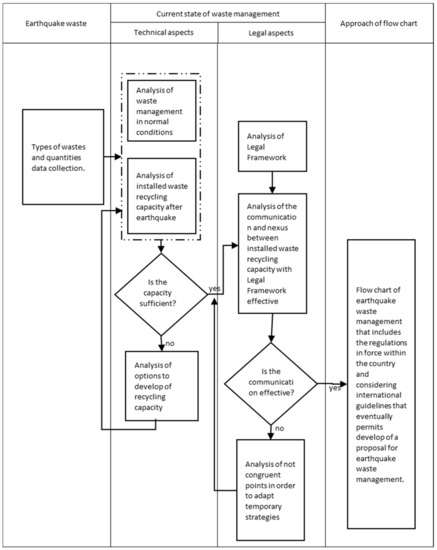
Figure 1.
Proposed framework for earthquake waste management in developing countries.
Waste estimation was based on data collection of wastes and quantities reported by the government, considering two types of debris: rubble and household items waste. After that, a study was developed to analyze the capacity installed to earthquake waste management by means of interviews due to the lack of institutional, congruent and public information in this country.
Furthermore, an analysis was developed of current legal and public policy aspects of disaster waste management in Mexico, from a federal and local perspective. Finally, a flowchart proposal was delineated for earthquake waste management.
2.1. Rubble from Collapsed and Demolished Buildings
The types of waste from programmed demolitions reported by the Urban Management Agency of Mexico City (AGU, acronym in Spanish) and observed in the field were rubble, metals (from some parts as windows), agglomerate from doors, masonry, plastic, glass and soil from the excavating of foundation (Table 1).

Table 1.
Types of waste from a programmed demolition. Arenal St. 120 Mexico City.
Is important to note that, from eleven earthquake waste case studies, that we review in Table 4 (namely, Canterbury 2010 earthquakes, New Zealand [5], Great East Japan 2011 earthquake [3], Emilia Rogmana 2012 earthquake, Italy [6] and Nepal earthquake 2015 [20] and eight articles reviewed by Brown et al. [8]), only Asari et al. [3] distinguished earthquake rubble from household items; meanwhile, the other surveys group both as part of general debris. The authors also consider it important, for the Mexican context, to differentiate household items from rubble, since combining these two categories hinders the planning for subsequent recycling. From this perspective, it is assumed that household items will turn about waste, if the dwellings are collapsed. Calculations were adapted to Mexico City from Tabata et al. [21].
2.2. Household Items Waste from Collapsed and Demolished Buildings
Collapsed buildings totaled 15, and the number of dwellings was 122, as was published in the report: “Plataforma de Derrumbes CDMX database” [16]. The amount of waste from collapsed buildings was estimated using the about household items in Mexico City reported in the National Household Income and Expenditure Survey 2016, published by the National Institute of Statistics and Geography (INEGI, acronym in Spanish). The metadata used estimated the average quarterly income based on location (i.e., Mexico City) size. Mexico City was classified as “urban” in this report. The average income per capita is USD 2610.00 per quarter [22], which corresponds to the statistical decile VIII, meaning households were assumed to possess the items listed in Table 2. Finally, it is assumed that the dwellings are composed on average by 3.9 people as indicated in the report.

Table 2.
Household equipment in Mexico City [21].
Although it remains complex to develop estimations about so-called companion animals, an estimation was made according to the study: “Subjective Welfare in Mexico” conducted by INEGI [23], from a sample of 6,710,885 adult individuals, 35.7% mentioned having companion animals, the total of pets are 2,617,996, of which 79.3% are dogs, 12.7% cats and 8% others. In other words, there are at least 1.52 companion animals for every 3.9 people, on average (however, some dwellings have three or four pets, meanwhile others have zero).
Table 2 is bounded to provide data about the household equipment. Due to the enormous complexity of earthquake waste composition, Table 2 is not exhaustive. This complexity comes from the number of people living in a house, as well as personal preferences. For instance, the authors take no account of items such as umbrellas, makeup articles, brushes, clocks, cloths for cleaning, plastic items, cooking pots and cutlery, clothing, detergents, jewelry, hazardous household waste (oils, pesticides, etc.), putrescible wastes (such as rotting food), etc. Weights and volumes of household items from Table 2 were estimated using information about which items are most commonly purchased, as reported in the document Purchase Compass 2017, published by Mexican Consumer Protection Federal Agency (PROFECO, acronym in Spanish) [24].
2.3. Waste Management Systems in Normal Conditions in Mexico City
Mexico City is one of the most populated cities around the world, with almost 9 million inhabitants and, therefore, faces a great challenge regarding the management of solid waste. According to official figures released by the Ministry of the Environment (Mexico City) (SEDEMA, acronym in Spanish), during 2017, annual waste generation amounted to 12,998 tons of solid waste per day, that is, an average per person of 1.37 kg per day. Of this, 3051.49 tons per day (23.44%) were recovered, of which 92% was recyclable material and 8% was food and gardening waste [25].
Wilson et al. [26] included Mexico City in their study on the role of informal sector recycling in waste management in developing countries, concluding that:
- Recycling is carried out by poor and marginalized social groups.
- There is a general rule that the less organized the sector is, the fewer people will be involved, which adds greater value to the raw and secondary materials that are collected, if risks such as health problems and exploitation of intermediaries are disregarded.
- When children are involved in informal sector recycling, they often forgo a formal education, which means that as they grow up, they cannot enter the formal labor sector.
Waste management after an earthquake is more complex than under normal conditions, because collapsed buildings present mixed and contaminated waste [27,28].
3. Results and Discussion
In order to present the results in an order with respect to the different types of waste, the debris results are shown first and then the results for household waste.
3.1. Estimated Amount of Rubble from Collapsed and Demolished Buildings
According to AGU, the volume of collapsed buildings totaled 54,908 m3; in order to estimate the tons of rubble, a factor of 1.9478 was used by them, so the weight was 106,949.8 tons. On the other hand, the volume of buildings programmed to demolition totaled 121,810 m3 (237,261.5 tons) [29].
3.2. Household Items Waste from Collapsed and Demolished Buildings
Measurements and statistical data of household item volumes and weights are showed in Table 3. Weights and volumes were estimated by averaging ten articles per item. From this, the estimated weight of earthquake waste considering only the household equipment mentioned in [22] per dwelling is 424.16 kg, which represents a volume of 10.17 m3 (Table 3).

Table 3.
Mass and volume per household items. Sample size: 10 items [24].
Table 4 shows the comparation of earthquake waste generation from Mexico City Earthquake, 2017 vs. published studies, notably, there is a low number of publications about earthquake waste management (12), only six studies about earthquake waste have been published in journals, four in proceedings and two in national reports (it is important to emphasize that the magnitude of these earthquakes varies from 5.9 to 9), in this sense, it is also possible to note that only three studies mentioned a waste generation estimation but no one corresponds to the three developing countries studies. These quantities are dramatic, since from the 40 earthquakes with a magnitude greater than 8 in the world [30], there are 21 datasets about earthquakes that occasioned collapsed buildings in developing countries, but none of them has a study published about the earthquake waste management, to the author’s knowledge.

Table 4.
Comparation of earthquake waste generation from Mexico City Earthquake, 2017 vs. studies published.
In order to draw a comparison about the weight of the waste generated in Mexico City and the waste generated by other earthquakes in other countries, it is possible to note that only two studies published their estimates of waste quantities: the earthquakes of 1994 Northridge, US [33] and 1995 Hyogoken-Nambu, Japan [34]. By calculating a simple proportion of the total weight of the waste between the number of collapsed buildings, in this case, the results are as follows: 17.5 tons of debris/building from 1994 Northridge Earthquake, US; 100 tons of debris/building from 1995 Japan Earthquake; 1840 tons of debris/building from 2017 Mexico City Earthquake [29]. The quantities differ by 1 and 2 orders of magnitude; Japan has the smallest quantity and Mexico the largest. In this sense, according to AGU reports [29], the buildings had an average of four to six floors, and the materials accounted for in the weighing include rubble, metals, agglomerate, masonry, plastic, glass and all soil from the excavating of foundation (see Table 1). Unfortunately, because neither Japan nor the USA describe the materials considered in the accounting and weighing, nor the number of floors of the buildings, is not possible to develop an equivalent comparison.
3.3. Mexican Recyclable Waste Processing Companies
There are 596 recyclable waste processing companies and temporary waste collection centers registered in Mexican Ministry of Environment and Natural Resources (SEMARNAT, acronym in Spanish) SEMARNAT [39] and SEDEMA [40] of which 191 correspond solely to waste collection. Table 5 shows the results of interviews undertaken to estimate the capacity to receive and subsequently recycle the waste generated by the September 2017 earthquake. Waste weights and volumes were taken from AGU [29] (rubble) and Table 3 (household items), considering 122 destroyed dwellings [16]. Regarding animal carcasses, municipal rabies centers are the public centers authorized to manage animals; they are sent to burial in pits or sanitary landfills in accordance with NOM-042-SSA2-2006 [41].

Table 5.
Review of Mexican recyclers.
Table 5 illustrates that recyclable processing companies have a reception capacity above 100% to process the waste generated by Mexico City after the 2017 earthquake. Namely, the 59 metal recyclers who answered the interview (20% from the total) indicated that each one could receive and easily process the total amount (28,286 tons); this represents a reception capacity of 59 times.
AGU reported that all metal from concrete was returned to owner after crushed works [29], and the rubble was sent to authorized controlled and uncontrolled landfills called “tiros”. The only construction and demolition recycler enterprise in the Mexico Concretos Reciclados plant has a process capacity of 2000 tons of construction and demolition (C&D) waste per day [42]. According with Environmental Standard NADF-007-RNAT-2013, this waste presents a daily generation in the country of 16,724 tons; in only Mexico City, daily generation is 7000 tons of C&D waste [43], of which, according with Mexican Chamber of Construction Industry (CMIC, acronym in Spanish), 49% corresponds to rubble, 39% to soil from excavation and 12% other [44]. Therefore, 3430 tons per day from rubble and concrete are susceptible to be processed in order to valorized them.
According to the CEO of Concretos Reciclados enterprise, they could expand operations if they would have to receive above their capacity; nevertheless, the enterprise receive less than 600 tons daily (8.57% of the total of the city); furthermore, they did not receive any demolition waste from collapsed buildings after last 2017 earthquake, because there is no policy public to encourage an adequate management of this waste (Enrique Granell, personal communication, 5 February 2018).
It is noteworthy that some surveys [45,46,47] studied the mechanical performance of recycled concrete coarse aggregates (RCA) and highlighted the possibility of using recycled aggregates to produce structural concrete; in that respect, it is commonly believed that the RCA has high porosity and high water absorption, compared to the concrete made with natural aggregate (NSA) [48]; however, according to Shayan and Xu [49], it can be used to produce high strength (50 MPa) structural concrete. In this context, Hasan et al. [48] investigated the feasibility of using recycled materials in concrete by focusing on the fracture mechanism of the specimens. They concluded that the compressive, flexural and splitting strengths of concrete made from recycled concrete stone aggregate (RSA) were greater than those of recycled brick aggregate (RBA). Aggregate failure, which is not acceptable for good quality concrete, has been observed in RBA concrete. Therefore, the use of RBA with NSA is not appropriate to produce good quality concrete but replacing natural stone aggregate with up to 30% of RSA can be effectively used.
Despite all of this, the main problem lies in motivating construction companies to use this material in new buildings, rather than sending C&D waste to recycling facilities. In fact, the Concretos Reciclados’ CEO mentions that construction companies do not buy recyclable material; the government is the only eventual customer (9% of the production). In other words, the recycling company accumulates 91% of the recycled material because of conflicts in existing legislation.
Karunasena et al. [50] developed a waste analysis based on the Sri Lankan response to the 2004 Asian Tsunami 2004. The analysis concluded that disaster waste recovery and reuse is not optimized in Sri Lanka. Most reusable and recyclable materials are disposed of in landfill sites, due to insufficient knowledge about recycling and because of a lack of capacity. Karunasena et al. [50] note that it is nearly impossible to maintain a disaster-specific waste management industry. Domingo and Luo [5] studied construction and demolition waste management after the Canterbury earthquake and identified insufficient capacity for waste processing.
On the other hand, the metal content (from refrigerators and white goods) were sent to metal melting companies in China. However, there is not information of materials nor quantities actually sent to a recycling process. Concerning other types of waste, wood and textile furniture (22,216.2 tons) are disposed in landfills [25]. In accordance with SEDEMA [51], electronic waste is separated by type of waste, disassembled and sent to 94 companies for recycling [39]. Two interviews were held with cars recyclers, which indicated that both could receive up to 500 units per month, to dismantle them and deliver metals and plastics to recycle; tires and textiles are sent to landfills, meanwhile liquids are sent to authorized enterprises. Finally, although hazardous waste, biological infectious waste and contaminated waste were not counted officially, they must have authorized processing before they are sent to their final destination (confinement, treatment or incineration) by companies authorized by SEMARNAT [52].
3.4. Legal and Regulatory Framework for Waste Management in Earthquake Conditions
In Mexico, the General Law of Ecological Equilibrium and Environmental Protection (LGEEPA, acronym in Spanish) establishes the framework of concurrent competencies of the three levels of government [53]. Each level has the power to develop, conduct and apply environmental policy, as well as to protect the environment and preserve and restore ecological balance within their jurisdiction [54]. Municipal solid waste and special waste management is the responsibility of municipal officials and the officials of Mexico City, while hazardous waste management is managed at a federal level. In 2003, the General Law for the Prevention and Integral Waste Management (LGPGIR, acronym in Spanish) was issued as part of the Federal Constitution of Mexico to promote sustainable development, by preventing the generation, and promoting the recovery and integral management of waste, as well as preventing soil contamination [55] (Figure 2). However, neither this law nor the associated regulations expressly regulate earthquake waste, which includes all waste categories.
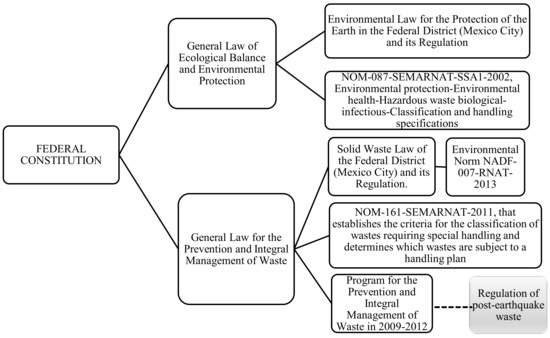
Figure 2.
Position of regulation of post-earthquake waste approach based on Mexican legal framework for the integral management of special handling waste.
Moreover, Mexico has two Official Mexican Standards issued by SEMARNAT. The first standard, NOM-161-SEMARNAT-2011, establishes the criteria for the classification of wastes requiring special handling and determines which wastes are subject to a handling plan. The standard lists the different types of waste, the procedure for the inclusion or exclusion of specific wastes from the list as well as the elements and procedures associated with the formulation of waste handling plans. This standard applies, at the federal level, to management plans for C&D waste generated by buildings exceeding 80 m3 [56].
The other standard is NOM-087-SEMARNAT-SSA1-2002, (named: Environmental Protection Environmental Health Hazardous Waste Biological Infectious Classification and Handling Specifications) [52], where biological infectious waste (BIW) is defined as those materials generated mainly during health care services that contain biological-infectious agents, and that may cause harmful effects to health and the environment.
In the local context, the Environmental Standard NADF-007-RNAT-2013 establishes the classification and management specifications for construction and demolition waste in Mexico City [43]; but is does not regulate earthquake waste. In addition, it is relevant to consider risks to health and the environment associated with some components of this waste in regular situations; this could be exacerbated post-earthquakes, when waste volumes increase significantly [8]. Therefore, it is necessary to stablish a public policy to use a percentage of recycled waste in construction industry framed in guidelines for the efficient use of resources, earthquakes resilience and risk reduction.
Nowadays, Mexico City lacks a policy on this matter; however, ten days after the earthquake of September 2017, SEMARNAT issued, in a reactive way, the document “Criterial for the Management of Construction and Demolition Waste” [57], where it is mentioned that it is prohibited to consider areas with high environmental value and flooding areas to place and operate a landfill. Nevertheless, waste was only retired from disaster places but did not have a recycling route; they were hardly disposed in landfills controlled and uncontrolled far from the city [29] (Figure 3).
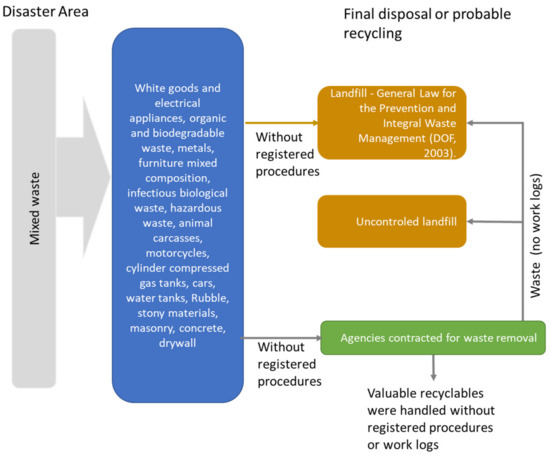
Figure 3.
Earthquake waste flow in Mexico City at present.
The Mexican federal government developed the National Program for Prevention and Integral Waste Management 2009–2012 (Figure 2), which refers to waste management during risk and disaster situations, through the following line of action: “Prepare general procedures, directories and necessary information to deal with extraordinary waste generation in risk or disaster situations with efficiency and effectiveness, training and adequate communication to the population” [58]. However, this proposal was part of a reactive and emergent policy, because registering procedures or work logs were not developed as Figure 3 presented.
In fact, in Mexico City, the Civil Protection Ministry takes the lead after an earthquake occurs, contracting agencies for waste removal. Prevention, preparedness and recovery are all they lead by the local government. In addition, because earthquake waste includes all classes of waste defined in Mexican law (i.e., municipal solid waste, special handling waste and hazardous waste), a management program must enable the articulation of both the Federation and Mexico City officials. Nonetheless, as it can be seen in Figure 2, the LGPGIR lays the groundwork for the regulation of earthquake waste, either through the official Mexican standards, or through specific strategies or programs.
These observations show that is essential to have a sustainable, post-earthquake waste strategy, dependent from government; however, when an earthquake comes and there is not a governmental strategy, a temporary strategy should establish a public policy that promotes the recycling waste process. Likewise, local authorities should locate and operate temporary collection centers with a sorting process efficient [59], where the disaster waste can be separated to facilitate delivery to recycling companies and offload landfills, as well as the establishment of registered procedures and work logs.
Subsequently, local governments must develop disaster waste management plans aimed at the prompt and their proper disposal, as recommended by Kawamoto and Kim [60].
According to the United Nations Office for the Coordination of Humanitarian Affairs Environmental Emergencies Section, Disaster Waste Management Guidelines, the removal and safe management of disaster waste, including earthquake waste, is an important part of the response to and recovery from disaster events. Effective risk management approaches to earthquake (and any other disaster) hazards contribute to the preparation, response and resilience of people’s safety, health and life, as well as the protection of ecosystems [28]. Nevertheless, after the 2017 Mexico City earthquake, there was no response action strategy for earthquake waste management. At the time of this study, neither the federal government nor the government of Mexico City have an articulate strategy for the sustainable management of earthquake waste. As Chávez and Bojórquez [61] suggest, this situation highlights the need to strengthen institutional capacities in terms of regulations and public policies to integrate an earthquake waste management program.
Different organizations present management options for disaster waste; in particular, the PAHO [62] guide was developed for Latin America and the Caribbean context. Although guidelines for disaster waste management exist at an international level, developing countries must adapt them to their own context [27,28,29,30,31,32,33,34,35,36,37,38,39,40,41,42,43,44,45,46,47,48,49,50,51,52,53,54,55,56,57,58,59,60,61,62,63]. Indeed, they fail to address the managerial and institutional components that influence the effectiveness of a disaster waste management system such as legislative considerations [8]. In addition, Asari et al. [3] conclude that it is necessary to identify the specific disaster with high risk, the waste management existent options and their priorities. Due to Mexico being prone to seismic activity [9], this study is focused on earthquake waste.
3.5. Approach of Flow Chart to Earthquake Waste Management in Mexico City
Given the above, based on types of debris, rubble and household items waste, the quantity of them, existing recycling processing companies, legal frameworks and international guidelines analyzed previously, a flowchart for an earthquake waste management proposal is presented in Figure 4.
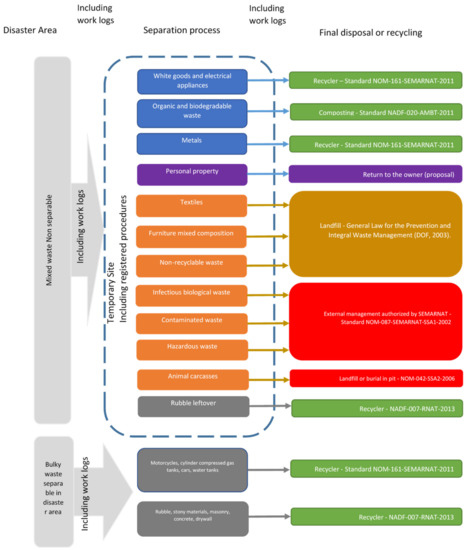
Figure 4.
Approach of flow chart to earthquake waste management in Mexico City.
The flow diagram has three columns. The first column indicates waste separation at the disaster site. The separation distinguishes non-separable mixed waste, which is sent to a temporary waste processing site, and separable bulky waste, including worklogs.
The second column indicates, within the dashed square, the temporary site where separation of waste should occur as suggested in UNOCHA [28] including registered procedures. Outside the dashed square are the bulky waste as vehicles, slabs, water tanks, cylinders containing compressed gas, trees, etc. These objects are suggested to be sent to recycling companies directly from the disaster site. The last column indicates the destination of each type of waste in accordance with Mexican Standards, with registered procedures and worklogs, i.e., recycler, incinerator, landfill or external management authorized by SEMARNAT. This column also points out the possibility that people could recover valuable personal items. In accordance with JSMCWM [27], it is desirable to enable the possibility for people to recover valuable personal properties, e.g., sentimental valuables such as photo albums; this study proposes to include wallets, jewelry, cell phones and laptops, IDs, personal documents, paintings, metal and stone sculptures, glasses and books.
4. Conclusions and Further Work
This study proposes a methodological framework for developing countries, which allows us to move from reactive actions made in response to an earthquake to temporary strategies that allow the removal of waste to be sent to possible recyclable processing centers, in accordance with current regulations in the country.
Based on the importance of analyzing the different waste from collapsed buildings, rubble and domestic waste, the authors made the estimations always separating these two elements, since it is considered that the union of these different types of waste makes recycling planning difficult.
In terms of the capacity installed to earthquake waste management, after the 2017 Earthquake in Mexico based on the findings, it is possible to conclude that recyclable processing companies in Mexico dedicated to rubble, white goods, biodegradable waste and metals have a reception and processing capacity above 100% of the estimated earthquake waste.
Is important to point out that the waste collection, its transport from the disaster site to recycling processing facilities, the operation of temporary collection centers, like so many important logistic aspects, are further objectives of this study; hence, further work is recommended about these points. On the other hand, although other Mexican cities and municipalities are affected by earthquakes, these are beyond the objectives of this study; thus, the authors recommend future research to address the different aspects of other municipalities affected by earthquakes in Mexico. Likewise, further studies are recommended to analyze the special aspects of another developing countries not included in the present work.
As of the analysis of the current legal framework, a scarce regulation of post-earthquake waste can be noticed, although there are some regulations that can be applied to earthquake waste tangentially; the truth is that integral and sustainable management plans of this type of waste are a pending task for the Mexican State and, therefore, for Mexico City, which must be approached from a participatory public policy.
Author Contributions
F.H.-P. (conceptualization; writing; funding acquisition; project administration; data collection; methodology; formal analysis; oversight); M.A. (writing; data collection; legal methodology; formal analysis; visualization; corrections; validation). All authors have read and agreed to the published version of the manuscript.
Funding
This research was funded with resources from the Program of Support for Research Projects and Technological Innovation (PAPIIT, by its name in Spanish: Programa de Apoyo a Proyectos de Investigación e Innovación Tecnológica) of National Autonomous University of Mexico. Project number TA101119.
Institutional Review Board Statement
Not applicable.
Informed Consent Statement
Not applicable.
Data Availability Statement
Publicly available datasets were analyzed in this study. This data can be found here
- a)
- https://www.inegi.org.mx/programas/enigh/nc/2016/ (accessed on 15 May 2019), an open-source online data repository hosted at https://www.inegi.org.mx/ (accessed on 15 May 2019) [22].
- b)
- https://reconstruccion.cdmx.gob.mx/censo/ (accessed on 20 December 2020), an open-source online data repository hosted at https://cdmx.gob.mx/ (accessed on 20 December 2020); Version: December 2017 [14]. As a result of the reconstruction actions, the original database that served as input for this research is constantly updated. However, if you are interested to know it, please request it by mail to florhp@comunidad.unam.mx.
- c)
- http://www.semarnat.gob.mx/archivosanteriores/transparencia/transparenciafocalizada/residuos/Documents/directorio_residuos.pdf (accessed on 2 January 2021) an open-source online data repository hosted at https://www.gob.mx/semarnat (accessed on 2 January 2021) [39].
- d)
- http://data.sedema.cdmx.gob.mx/nadf24/images/infografias/planes_de_manejo_autorizados.pdf (accessed on 20 December 2020), an open-source online data repository hosted at https://cdmx.gob.mx/ (accessed on 20 December 2020) [40].
- e)
- https://www.sedema.cdmx.gob.mx/storage/app/media/IRS_2017_FINAL_BAJA.pdf (accessed on 15 May 2019), an open-source online data repository hosted at https://cdmx.gob.mx/ (accessed on 15 May 2019) [25].
- f)
- http://gaceta.diputados.gob.mx/Gaceta/64/2018/dic/CDMX_reconstruc-20181211.pdf (accessed on 2 January 2021), an open-source online (AGU data repository) hosted at http://gaceta.diputados.gob.mx/ (accessed on 2 January 2021) [29].
Acknowledgments
The study received valuable support from undergraduate mechanical engineering students: Marco Antonio Rojas Nava and Alan Gerardo Reyes Ramírez for conducting interviews.
Conflicts of Interest
The authors declare no known conflict of interest associated with this publication.
Abbreviations
| ISC | Mexican Institute of Construction Security (acronym in Spanish) |
| SEDUVI | Ministry of Urban Development and Housing (acronym in Spanish) |
| SEDEMA | Ministry of the Environment (Mexico City) (acronym in Spanish) |
| INEGI | National Institute of Statistics and Geography (acronym in Spanish) |
| AGU | Urban Management Agency of Mexico City (acronym in Spanish) |
| PROFECO | Mexican Consumer Protection Federal Agency (acronym in Spanish) |
| SEMARNAT | Mexican Ministry of Environment and Natural Resources (acronym in Spanish) |
| CMIC | Mexican Chamber of Construction Industry (acronym in Spanish) |
| NOM | Mandatory Technical Regulation (acronym in Spanish) |
References
- Rafee, N.; Karbassi, A.R.; Nouri, J.; Safari, E.; Mehrdadi, M. Strategic management of municipal debris aftermath of an earthquake. Int. J. Environ. Res. 2008, 2, 205–214. [Google Scholar] [CrossRef]
- Brown, C. Disaster Waste Management: New Zealand Experiences and Future Planning. 2012. Available online: https://www.eqc.govt.nz/sites/public_files/1794-disaster-waste-management.pdf (accessed on 2 April 2012).
- Asari, M.; Sakai, S.I.; Yoshioka, T.; Tojo, Y.; Tasaki, T.; Takigami, H.; Watanabe, K. Strategy for separation and treatment of disaster waste: A manual for earthquake and tsunami disaster waste management in Japan. J. Mater. Cycles Waste Manag. 2013, 15, 290–299. [Google Scholar] [CrossRef]
- Brown, C.; Milke, M. Recycling disaster waste: Feasibility, method and effectiveness. Resour. Conserv. Recycl. 2016, 106, 21–32. [Google Scholar] [CrossRef]
- Domingo, N.; Luo, H. Canterbury earthquake construction and demolition waste management: Issues and improvement suggestions. Int. J. Disaster Risk Reduct. 2017, 22, 130–138. [Google Scholar] [CrossRef]
- Faleschini, F.; Zanini, M.A.; Hofer, L.; Pellegrino, C. Demolition Waste Management After Recent Italian Earthquake. In Proceedings of the Sardinia 2017/Sixteenth International Waste Management and Landfill Symposium, Cagliari, Italy, 2–6 October 2017; 24. [Google Scholar]
- UNISDR. Chart of the Sendai Framework for Disaster Risk Reduction. 2015. Available online: https://www.unisdr.org/we/coordinate/sendai-framework (accessed on 12 December 2020).
- Brown, C.; Milke, M.; Seville, E. Disaster waste management: A review article. Waste Manag. 2011, 31, 1085–1098. [Google Scholar] [CrossRef] [PubMed]
- Pérez-Campos, X. UNAM Experts Call to Be Alert to Possible Aftershocks of September 7, 2017 (in Spanish). General Direction of Social Communication; UNAM: Mexico City, Mexico, 2017. [Google Scholar]
- UNOCHA. México: Earthquake 8.2 Degrees Ritcher Situation Report No. 01 of the Office of the Resident Coordinator. National Adviser in Response to OCHA Disasters in México; UNOCHA: New York, NY, USA; Istanbul, Turkey, 2017. [Google Scholar]
- CRED. EM-DAT, the International Disasters Database, Brussels, Centre for Research on the Epidemiology of Disasters. 2019. Available online: https://www.emdat.be (accessed on 7 May 2019).
- PAHO-WHO. Earthquake Mexico–Situation Analysis; PAHO-WHO: Washington, DC, USA, 2017; Available online: https://www.paho.org/disasters/index.php?option=com_docman&view=download&category_slug=mexico-earthquake-september-2017-1232&alias=2544-paho-who-situation-report-mexico-earthquake-26-september-2017-544&Itemid=1179&lang=en (accessed on 16 December 2020).
- Puente, L.F. Total Update 369 Deceased by Earthquake 19/09/17 (in Spanish); Twitter: San Francisco, CA, USA, 2017. [Google Scholar]
- SEDUVI. Census of Affected Properties; Ministry of Human Development and Housing: México City, México, 2018; (In Spanish). Available online: https://www.plataforma.cdmx.gob.mx/storage/app/archivos/paginaid-5/catid-147/135debd4837026bf06c7bfc5d1e0c6a31611af1d.pdf (accessed on 20 December 2020).
- Government of Mexico City. Results of the census and of the validation of the Commission for the Reconstruction of buildings damaged in the last earthquake of September 19, 2017; Commission for Reconstruction: México City, México, 2019; (In Spanish). Available online: https://reconstruccion.cdmx.gob.mx/censo (accessed on 16 January 2021).
- Rebuilding Commission. List of Companies for the Rehabilitation and Reconstruction of Buildings in the CDMX (in Spanish). 2019. Available online: https://www.plataforma.cdmx.gob.mx/ (accessed on 16 November 2020).
- SMIE. Rules for the Seismic Rehabilitation of Concrete Buildings Damaged by the September 19 Earthquake, 2017. 2017. Available online: http://www.smie.org.mx/layout/reglamentos-construccion/ciudad-de-mexico-standards-rehabilitation-seismic-buildings-damaged-2017.pdf (accessed on 20 December 2020).
- Perló-Cohen, M. Rebuilding Commission Workgroup experiences after 2017 earthquake. In Proceedings of the Earthquakes, Disasters and Reconstruction Seminar, Mexico City, México, 19 September 2019. [Google Scholar]
- Marchesini, G.; Beraud, H.; Barroca, B. Quantification of disaster waste: Review of the available methods. Int. J. Disaster Risk Reduct. 2021, 53, 1–13. [Google Scholar] [CrossRef]
- Dugar, N.; Karajit, S.; Khatiwada, N.; Sharya, S.; Guimire, A. Post disaster waste management: Lessons learnt from 2015 Nepal earthquake. In Proceedings of the Global Waste Management Conference, Bangkok, Thailand, 1–2 August 2017. [Google Scholar] [CrossRef]
- Tabata, T.; Zhang, O.; Yamanaka, Y.; Tsai, P. Estimating potential disaster waste generation for pre-disaster waste management. Clean Technol. Environ. Policy 2016, 18, 1735–1744. [Google Scholar] [CrossRef]
- INEGI. National Household Income and Expenditure Survey (in Spanish). 2016. Available online: https://www.inegi.org.mx/programas/enigh/nc/2016 (accessed on 15 May 2019).
- INEGI. Subjective Welfare in Mexico. Expanded BIARE Module (in Spanish). 2014. Available online: https://www.inegi.org.mx/investigacion/bienestar/ampliado/default.html (accessed on 22 December 2020).
- PROFECO. Purchase compass 2017 (in Spanish). 2017. Available online: https://www.gob.mx/profeco/documentos/brujula-de-compra-93655?state=published (accessed on 26 December 2020).
- SEDEMA. México City, Solid Waste Inventory (in Spanish). 2018. Available online: https://www.sedema.cdmx.gob.mx/storage/app/media/IRS_2017_FINAL_BAJA.pdf (accessed on 15 May 2019).
- Wilson, D.C.; Velis, C.; Cheeseman, C. Role of informal sector recycling in waste management in developing countries. Habitat. Int. 2006, 30, 797–808. [Google Scholar] [CrossRef]
- JSMCWM. Strategy of Separation and Treatment of Disaster Waste. Focusing on the Great East Japan Earthquake 2011. 2012. Available online: http://eprc.kyoto-u.ac.jp/saigai (accessed on 18 December 2020).
- UNOCHA. Disaster Waste Management Guidelines, 2nd ed.; UNOCHA: New York, NY, USA; Istanbul, Turkey, 2011. [Google Scholar]
- AGU. Report of the Demolition, Haul and Final Disposal Plans Generated by the 2017 Earthquake in México City; AGU: Washington, DC, USA, 2018. [Google Scholar]
- IRIS. IRIS Earthquake Browser (IEB); Incorporated Research Institutions for Seismology: Washington, DC, USA, 2020; Available online: http://ds.iris.edu/ieb/index.html?format=text&nodata=404&starttime=1970-01-01&endtime=2025-01-01&minmag=7.3&maxmag=16&orderby=mag-desc&src=iris&limit=200&maxlat=88.02&minlat=-81.55&maxlon=180.00&minlon=-180.00&zm=1&mt=ter (accessed on 14 December 2020).
- California Government. Integrated Waste Management Disaster Plan: Guidance for Local Government on Disaster Debris Management; California Government: Sacramento, CA, USA, 1997.
- Reinhart, D.R.; McCreanor, P.T. Disaster Debris Management—Planning Tools; Final Report; US Environmental Protection Agency: Orlando, FL, USA, 1999. [Google Scholar]
- USEPA. Planning for Natural Disaster Debris. 2008. Available online: https://www.epa.gov/sites/production/files/2015-08/documents/pndd.pdf (accessed on 20 January 2021).
- Haruo, H.; Katsumi, T. Generation and Management of Disaster Waste. Soils Found. 1996, 36, 349–358. [Google Scholar]
- Eerland, D.W. Experience with the Construction and Demolition Waste Recycling in the Netherlands—Its Application to Earthquake Waste Recycling in Kobe; International Symposium on Earthquake Waste (IETC): Osaka, Japan, 1995. [Google Scholar]
- Baycan, F. Emergency Planning for Disaster Waste: A Proposal Based on the Experience of the Marmara Earthquake in Turkey. In Proceedings of the International Conference and Student Competition on post-disaster reconstruction “Planning for reconstruction”, Coventry, UK, 22–23 April 2004; pp. 1361–1375. [Google Scholar]
- Benouar, D. Integrated disaster management of the Algiers-Boumerdes (Algeria) Earthquake of 21 may 2003. In Proceedings of the International Disaster and Risk Conference (IDRC), Chengdu, China, 13–15 July 2009; pp. 13–15. [Google Scholar]
- Memon, M.A. Disaster waste recovery and utilization in developing countries-Learning from earthquakes in Nepal. In Proceedings of the 15th Asian Regional Conference on Soil Mechanics and Geotechnical Engineering, ARC 2015: New Innovations and Sustainability, Fukuoka, Japan, 9–13 November 2015; pp. 143–147. [Google Scholar] [CrossRef]
- SEMARNAT. Directory of Collection Centers for Materials from Waste in México 2010 (In Spanish). 2010. Available online: http://www.semarnat.gob.mx/archivosanteriores/transparencia/transparenciafocalizada/residuos/Documents/directorio_residuos.pdf (accessed on 2 January 2021).
- SEDEMA. Directory of Urban Waste Collection Centers in the CDMX (in Spanish). 2019. Available online: http://data.sedema.cdmx.gob.mx/nadf24/images/infografias/planes_de_manejo_autorizados.pdf (accessed on 20 December 2020).
- DOF. Prevention and control of diseases. Sanitary specifications for canine care centers; NOM-042-SSA2-2006 (In Spanish). Diario Oficial de la Federación. 6 November 2008. Available online: http://www.diariooficial.gob.mx/normasOficiales.php?codp=3529&view=si (accessed on 11 January 2021).
- Concretos Reciclados (in Spanish). Process and Facilities. 2019. Available online: http://www.concretosreciclados.com.mx (accessed on 15 May 2019).
- Specifications for Construction and Demolition Waste in the México City; NADF-007-RNAT-2013. Available online: https://data.consejeria.cdmx.gob.mx/portal_old/uploads/gacetas/474c43cf1c28f8f6f69aa7a3452614f8.pdf (accessed on 17 December 2020).
- CMIC. Construction and Demolition Waste Management Plan; Mexican Chamber of Construction Industry: México City, México, 2014; (In Spanish). Available online: https://www.cmic.org.mx/comisiones/Sectoriales/medioambiente/Flayer/PMRCDCompleto.pdf (accessed on 8 October 2019).
- Al-Zahraa, F.I.; El-Mihilmy, M.T.; Bahaa, T.M. Flexural strength of concrete beams with recycled concrete aggregates. J. Eng. Appl. Sci. 2010, 57, 355–375. [Google Scholar]
- Hoffmann, C.; Schubert, S.; Leemann, A.; Motavalli, M. Recycled concrete and mixed rubble as aggregates: Influence of variations in composition on the concrete properties and their use as structural material. Constr. Build. Mater. 2012, 35, 701–709. [Google Scholar] [CrossRef]
- Wagih, A.M.; El-Karmoty, H.Z.; Ebid, M.; Okba, S.H. Recycled construction and demolition concrete waste as aggregate for structural concrete. HBRC J. 2013, 9, 193–200. [Google Scholar] [CrossRef]
- Hasan, A.; Kibria, M.G.; Hasan, F.M.M. Effects of incorporating recycled brick and stone aggregate as replacement of natural stone aggregate in concrete. Int. J. Eng. Technol. Innov. 2019, 9, 38–48. [Google Scholar]
- Shayan, A.; Xu, A. Performance and Properties of Structural Concrete made with Recycled Concrete Aggregate. ACI Mater. J. 2003, 100, 371–380. [Google Scholar]
- Karunasena, G.; Amaratunga, D.; Haigh, R.; Lill, I. Post disaster waste management strategies in developing countries: Case of Sri Lanka. Int. J. Strateg. Manag. 2009, 13, 171–190. [Google Scholar] [CrossRef]
- SEDEMA. Days Collecting Electronic and Electrical Waste. (In Spanish). 2019. Available online: http://data.sedema.cdmx.gob.mx/reciclatron/index.html#.Xbcq-NWjk2x (accessed on 15 November 2020).
- Environmental Protection—Environmental Health—Biological—infectious hazardous wastes—Classification; NOM-087-SEMARNAT-SSA1-2002. Available online: http://dof.gob.mx/nota_detalle.php?codigo=704675&fecha=17/02/2003 (accessed on 12 October 2020).
- DOF. General Law of Ecological Equilibrium and Environmental Protection (LGEEPA, acronym in Spanish). Diario Oficial de la Federación 1988, 63, 479–493. [Google Scholar]
- Anglés, M.; Rovalo, M. The Oxford Handbook of Comparative Environmental Law; Lee, J.E., Viñuales, E., Eds.; Oxford University Press: Oxford, UK, 2019. [Google Scholar]
- DOF. General law for the prevention and integral management of waste (LGPGIR, acronym in Spanish 1988). Available online: http://www.diputados.gob.mx/LeyesBiblio/pdf/263_180121.pdf (accessed on 22 February 2021).
- DOF. Criteria for the classification of wastes requiring special handling and determines which wastes are subject to a handling plan; the list of these types of waste, the procedure. 2013. Available online: http://www.dof.gob.mx/nota_detalle.php?codigo=5286505&fecha=01/02/2013#:~:text=NORMA%20Oficial%20Mexicana%20NOM%2D161,elementos%20y%20procedimientos%20para%20la (accessed on 17 September 2020).
- SEMARNAT. Criteria for the Management of Construction and Demolition Waste; Mexican Ministry of Environment and Natural Resources (SEMARNAT, acronym in Spanish): México City, México, 2017. Available online: https://www.gob.mx/cms/uploads/attachment/file/259191/Criterios_RIC_Sismo_19_septiembre.pdf (accessed on 11 September 2020).
- SEMARNAT. National Program for the Prevention and Integral Management of Waste 2009–2012 (in Spanish). 2009. Available online: https://www.gob.mx/cms/uploads/attachment/file/187438/pnpgir_2009-2012.pdf (accessed on 15 October 2020).
- Habib, M.S.; Sarkar, B. An integrated location-allocation model for temporary disaster debris management under an uncertain environment. Sustainability 2017, 9, 716. [Google Scholar] [CrossRef]
- Kawamoto, K.; Kim, K. Efficiencies of bonding, bridging and linking social capital: Cleaning up after disasters in Japan. Int. J. Disaster Risk Reduct. 2019, 33, 64–73. [Google Scholar] [CrossRef]
- Chávez, R.; Bojórquez, E. Seismic hazard maps based on the intensity measure I Np. KSCE J. Civ. Eng. 2018, 22, 247–256. [Google Scholar] [CrossRef]
- PAHO. Solid Waste Management in Disaster Situations; PAHO: Washington, DC, USA, 2003. (In Spanish) [Google Scholar]
- Al-Nammari, F.; Alzaghal, M. Towards local disaster risk reduction in developing countries: Challenges from Jordan. Int. J. Disaster Risk Reduct. 2015, 12, 34–41. [Google Scholar] [CrossRef]
Publisher’s Note: MDPI stays neutral with regard to jurisdictional claims in published maps and institutional affiliations. |
© 2021 by the authors. Licensee MDPI, Basel, Switzerland. This article is an open access article distributed under the terms and conditions of the Creative Commons Attribution (CC BY) license (http://creativecommons.org/licenses/by/4.0/).
